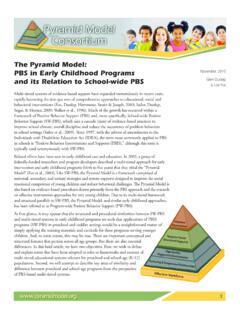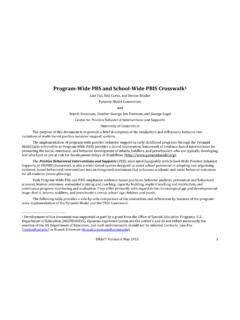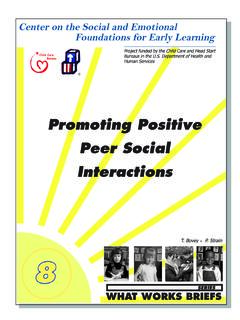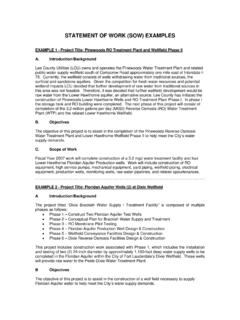Transcription of “You Got It!” - University of South Florida
1 Beyond the Journal Young Children on the Web November 20061 BuildingSocialSkillsEARLY EDUCATORS REPORT that one of their biggest challenges is supportingyoung children who have problem behavior beyond what might be expected(Buscemi et al. 1995; Hemmeter, Corso, & Cheatham 2005). Some childrenengage in problem behavior that is typical of a particular stage of develop-ment as they build relationships with peers and adults and learn to navigatethe classroom environment. For example, a toddler might grab a crackerfrom another child s plate because she is still learning to use words to askfor what she wants or needs.
2 What troubles teachers is how to meet theneeds of children who have persistent problem behavior that does notrespond to positive guidance or prevention practices. The extent of thisproblem is highlighted by recent reports on the rates of expulsion of chil-dren from preschool programs (Gilliam 2005).The teaching pyramidThe teaching pyramid model (Fox etal. 2003) describes a primary level ofuniversal practices classroompreventive practices that pro-mote the social and emotionaldevelopment of all children built on a foundation ofpositive relationships;secondary interventionsthat address specificsocial and emotionallearning needs ofchildren at risk forchallenging behavior;and development of individualized interventions (tertiary level) for childrenwith persistent problem behavior (see the diagram The Teaching Pyra-mid ).
3 The model is explained more fully in The Teaching Pyramid: A Model You Got It! Teaching Social andEmotional SkillsLise Fox and Rochelle Harper LentiniLise Fox, PhD, is a professor in theDepartment of Child and Family Studiesof the Louis de la Parte Florida MentalHealth Institute of the University of SouthFlorida in Tampa. She conducts researchand training and develops supportprograms focused on young children withchallenging Harper Lentini, MEd, is afaculty member in the Department ofChild and Family Studies of the Louis dela Parte Florida Mental Health provides training and technicalassistance to early educators and fami-lies on supporting young children withchallenging behavior and promotingsocial and emotional of this article was sup-ported by the Center for Evidence-BasedPractice.
4 Young Children with Challeng-ing Behavior (Office of Special EducationPrograms, Department of Educa-tion, Cooperative Agreement#H324Z010001) and the Center on theSocial and Emotional Foundations forEarly Learning (Administration for Chil-dren and Families, Department ofHealth and Human Services, CooperativeAgreement #90YD0119/01).Teaching Pyramid diagram adaptedfrom L. Fox, G. Dunlap, Hemmeter, Joseph, & Strain, The Teach-ing Pyramid: A Model for SupportingSocial Competence and PreventingChallenging Behavior in Young Children, Young Children 58 (July 2003): courtesy of the authors.
5 Illus-tration Adjoa Teaching PyramidSecondaryLevelIntensiveIndividual InterventionsSocial and EmotionalTeaching StrategiesPrimaryLevelPositive Relationships with Children,Families, and ColleaguesClassroom Preventive practicesBeyond the Journal Young Children on the Web November 20062 BuildingSocialSkillsfor Supporting Social Competence andReinventing Challenging Behavior inYoung Children, in the July 2003 issueof Young foundation for universal prac-tices begins with nurturing and re-sponsive caregiving that supportschildren in developing a positive senseof self and in engaging in relationshipswith others.
6 At this level, teachersfocus on their relationships withchildren and families. Universal class-room practices include developmentally appropriate, child-centered classroomenvironments that promote children s developing independence, successful inter-actions, and engagement in learning. While universal practices may be enough topromote the development of social competence in the majority of children in theclassroom, teachers may find that there are children whose lack of social andemotional skills or whose challenging behavior requires more focused this article we look at the secondary level of the teaching pyramid, whichemphasizes planned instruction on specific social and emotional skills for childrenat risk for developing more challenging behavior, such as severe aggression, prop-erty destruction, noncompliance, or withdrawal.
7 Children who may be consideredat risk for challenging behavior are persistently noncompliant, have difficultyregulating their emotions, do not easily form relationships with adults and otherchildren, have difficulty engaging in learning activities, and are perceived by teach-ers as being likely to develop more intractable behavior shows that when educators teach children the key skills they need tounderstand their emotions and the emotions of others, handle conflicts, problemsolve, and develop relationships with peers, their problem behavior decreases andtheir social skills improve (Joseph & Strain 2003).
8 Emphasis on teaching socialskills is just one component of multiple strategies to support a child at risk forchallenging behavior. Additional critical strategies include collaborating with thefamily; addressing the child s physical and mental health needs; and offering thesupport of specialists and other resources to address the child or family s indi-vidual problem behaviorThe teaching pyramid model guides teachers to view a child s problem behavioras serving a purpose for that child. Some children may use problem behaviorinstead of socially conventional and appropriate behavior to avoid or join interac-tions and activities, obtain or avoid attention, and obtain objects.
9 For example, achild who wants another child s toy may hit the other child instead of asking tohave a turn with the toy. Other children may use problem behavior to express theirdisappointment or anger to the teacher, rather than asking for help or sharingtheir feelings with words. For example, a child may throw toys or destroy materialswhen frustrated rather than asking a teacher for for challenging behaviorChildren may use problem behavior to get their needs met for a variety of rea-sons. For example, a child may have language development problems, social-emotional delays, difficulties with peer interactions, or developmental disabilities;Teachers may findthat there arechildren whoselack of social andemotional skills orwhose challengingbehavior requiresmore the Journal Young Children on the Web November 20063 BuildingSocialSkillsshe may have experienced neglect or trauma.
10 Or she may simply have not hadopportunities to learn appropriate social or communication skills before teachers view challenging behavior as actions children use to get theirneeds met, they can reframe problem behavior as a skill-learning or skill-fluencyissue. Skill fluency refers to a child s ability to use a skill consistently and indepen-dently. Children with problem behavior may not have appropriate social or communi-cation skills or may not use those skills well in a variety of situations. Reframingproblem behavior as a skill-instruction issue opens the door to the development ofeffective strategies teachers can implement in the classroom: if young childrenwith problem behavior are missing key social and communication skills, then anext step is to teach them those skills!

















